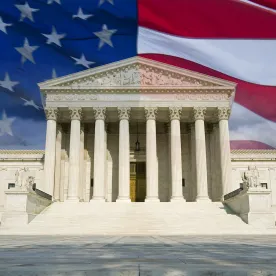The U.S. Supreme Court agreed to hear a case in its coming term concerning whether an employer might bring a state law tort claim for property damage or whether such claims are preempted by the National Labor Relations Act (NLRA).
In 2017, a work stoppage by 16 truck drivers for Glacier Northwest, Inc., doing business as CalPortland, resulted in the spoilage of 16 loads of cement. Glacier claimed the drivers who had walked off the job had coordinated with the Teamsters Local Union, No. 174 while it was negotiating a new collective bargaining agreement with the union.
Glacier brought suit against the union in Washington state court for torts related to the property damage it suffered due to the work stoppage and loss of usable cement in Glacier Nw., Inc. v. Int'l Bhd. of Teamsters Local Union No. 174, 500 P.3d 119 (2021). The union filed a motion to dismiss these tort claims as preempted by the NLRA, which the trial court granted. The Washington Court of Appeals reversed, holding that the intentional destruction of property during a work stoppage was not activity protected by the NLRA. The union appealed the issue to the Washington Supreme Court, which in turn reversed the appeals court, holding the trial court properly dismissed these claims as preempted by the NLRA since the damages were incidental to a strike “arguably subject” to federal law.
Following this decision, in May 2022, Glacier petitioned the U.S. Supreme Court for certiorari to review the decision of the Washington Supreme Court. In agreeing to hear this case, the U.S. Supreme Court has the chance to clarify what types of claims are not preempted by the NLRA.
Federal Courts’ Interpretations of NLRA
The U.S. Supreme Court has long recognized that the NLRA preempts certain types of claims against unions and employees engaging in protected activity. This doctrine dates back to its decision in San Diego Building Trades Council v. Garmon, 359 U.S. 236 (1959). In Garmon, the court held the NLRA preempts state law claims that are based on conduct “arguably subject” to Section 7 (protecting concerted activities in collective bargaining) or Section 8 (prohibiting unfair labor practices) of the NLRA. This, however, carves out claims that qualify under the “local feeling” exception. Such claims are typically those that concern areas of law traditionally reserved to the states, such as tort law claims arising under state law.
Since Garmon, federal circuit courts and state courts have been left to determine what might be “arguably subject” to the NLRA or so deeply rooted in “local feeling” as to not have been the subject of indirect Congressional preemption. This has resulted in a patchwork of decisions declaring various state law claims as preempted by the NLRA or otherwise actionable under state law, with the Washington Supreme Court’s decision being the latest interpretation of the doctrine.
Now, over 60 years after issuing its ruling in Garmon, the court’s decision to grant certiorari to Glacier’s petition might mean it’s ready to issue some concrete guidance on Garmon preemption.
The fact that the court is comprised of a 6-3 conservative majority might signal some likely success for an employer like Glacier, but untangling 63 years of precedent and a jurisdictional split will not be an easy task. A decision for Glacier would likely make it easier for employers to recover property damage they suffer incidental to a strike. Even more so, the availability of punitive damages under state tort law would provide an effective disincentive for employees or unions that might otherwise engage in reckless or malicious conduct while exercising their rights under the NLRA. The implications of a decision for the Teamsters, however, is a little more unclear. In a rapidly changing labor landscape dominated by an aggressive pro-union NLRB, such a decision might have a chilling effect and strip such claims of any viability.
How the U.S. Supreme Court will rule on this issue is to be determined, but a decision either way is sure to have significant consequences for the future of labor relations. Having agreed to hear this case, the Supreme Court will have the chance to cement the viability of state law tort claims for employers or it just might leave such claims with a pair of cement shoes.




 />i
/>i

